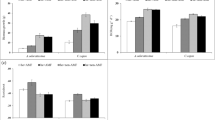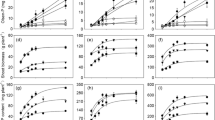Abstract
The seasonality of arbuscular mycorrhizal (AM) fungi–plant symbiosis in Lotus glaber Mill. and Stenotaphrum secundatum (Walt.) O.K. and the association with phosphorus (P) plant nutrition were studied in a saline-sodic soil at the four seasons during a year. Plant roots of both species were densely colonized by AM fungi (90 and 73%, respectively in L. glaber and S. secundatum) at high values of soil pH (9.2) and exchangeable sodium percentage (65%). The percentage of colonized root length differed between species and showed seasonality. The morphology of root colonization had a similar pattern in both species. The arbuscular colonization fraction increased at the beginning of the growing season and was positively associated with increased P concentration in both shoot and root tissue. The vesicular colonization fraction was high in summer when plants suffer from stress imposed by high temperatures and drought periods, and negatively associated with P in plant tissue. Spore and hyphal densities in soil were not associated with AM root colonization and did not show seasonality. Our results suggest that AM fungi can survive and colonize L. glaber and S. secundatum roots adapted to extreme saline-sodic soil condition. The symbiosis responds to seasonality and P uptake by the host altering the morphology of root colonization.



Similar content being viewed by others
References
Abbott L, Robson A (1991) Factors influencing the occurrence of vesicular arbuscular mycorrhizas. Agric Ecosyst Environ 35:121–150
Abbott LK, Robson AD, De Boer G (1984) The effect of phosphorus on the formation of hyphae in soil by the vesicular-arbuscular mycorrhizal fungus, Glomus fasciculatum. New Phytol 97:437–446
Al-Karaki GN (2000) Growth of mycorrhizal tomato and mineral acquisition under salt stress. Mycorrhiza 10:51–54
Allen MF (1983) Formation of vesicular-arbuscular mycorrhizae in Atriplex gardneri (Chenopodiaceae): seasonal response in a cold desert. Mycologia 75:773–776
Allen MF (1996) The ecology of arbuscular mycorrhizas: a look back into the 20th century and peek into the 21st. Mycol Res 100:769–782
Amijee F, Tinker PB, Stribley DP (1989) The development of endomycorrhizal systems. VII. A detailed study of the effects of soil phosphorus on colonization. New Phytol 111:435–446
Bentivenga SP, Hetrick BAD (1992) Seasonal and temperature effects on mycorrhizal activity and dependence of cool- and warm-season tallgrass prairie grasses. Can J Bot 70:1596–1602
Biermann B, Linderman RG (1983) Use of vesicular-arbuscular mycorrhizal roots, intraradical vesicles and extraradical vesicles as inoculum. New Phytol 95:97–105
Blaszkowski J, Madej T, Tadych M (1998) Entrophospora baltica sp. nov. and Glomus fuegianum, two species in the Glomales from Poland. Mycotaxon 68:165–184
Bray RH, Kurtz LT (1945) Determination of total organic and available forms of phosphorus in soils. Soil Sci 59:39–45
Bremmer JM, Mulvaney CS (1982) Nitrogen total. In: Black CA (ed) Methods in soil analysis: agronomy. American Society of Agronomy. Inc. Madison, Wisconsin, USA, pp 595–624
Carvalho LM, Correia PM, Martins-Loução MA (2004) Arbuscular mycorrhizal fungal propagules in a salt marsh. Mycorrhiza 14:165–170
Daniels N, Skipper H (1982) Methods for the recovery and quantitative estimation of propagules from soil. In: Schenck NC (ed) Methods and principles of mycorrhizal research. American Phytopathology Society. St. Paul, MI, USA, pp 29–35
DeMars BG, Boerner REJ (1995) Mycorrhizal dynamics of three woodland herbs of contrasting phenology along topographic gradients. Am J Bot 82:1426–1431
Entry JA, Rygiewicz PT, Watrud LS, Donnelly PK (2002) Influence of adverse soil conditions on the formation and function of arbuscular mycorrhizas. Adv Environ Res 7:123–138
Escudero VG, Mendoza RE (2005) Seasonal variation of arbuscular mycorrhizal fungi in temperate grasslands along a wide hydrologic gradient. Mycorrhiza 15:291–299
Gavito ME, Varela L (1993) Seasonal dynamic of mycorrhizal associations in maize fields under low input agriculture. Agric Ecosyst Environ 45:275–282
Giovannetti M, Mosse B (1980) An evaluation of techniques for measuring vesicular arbuscular mycorrhizal infection in roots. New Phytol 84:489–500
Graham JH (1986) Citrus mycorrhizae: potential benefits and interactions with pathogens. HortScience 21:1302–1306
Guadarrama P, Álvarez-Sánchez FJ (1999) Abundance of arbuscular mycorrhizal fungi spores in different environments in a tropical rain forest, Veracruz, México. Mycorrhiza 8:267–270
Ingham E, Wilson M (1999) The mycorrhizal colonization of six wetland species at sites differing in land use history. Mycorrhiza 9:233–235
Jackson ML (1958) Soil chemical analysis. In: Black CA, Evans DD, White JR, Ensminger GE, Clarck FE (eds) Method of soil analysis, Part 2. Chemical and microbiological properties. Prentice Hall, Englewood Cliffs, p 801
Jain PK, Paliwal K, Dixon RK, Gjerstad DH (1989) Improving productivity of multipurpose trees on substandard soil in India. J For 87:38–42
Johnson NC, Tilman D, Wedin D (1992) Plant and soil controls on mycorrhizal fungi. Ecology 73:2034–2042
Juniper S, Abbott L (1993) Vesicular–arbuscular mycorrhizas and soil salinity. Mycorrhiza 4:45–57
Landwehr M, Hildebradt U, Wilde P, Nawrath K, Tóth T, Biró B, Bothe H (2002) The arbuscular mycorrhizal fungus Glomus geosporum in European saline, sodic and gypsum soils. Mycorrhiza 12:199–211
Lavado RS, Rubio G, Alconada M (1992) Grazing management and soil salinization in two Pampean natraqualfs. Turrialba 42:500–508
Lugo MA, Cabello MN (2003) Arbuscular mycorrhizal fungi in a mountain grassland II: Seasonal variation of colonization studied, along with its relation to grazing and metabolic host type. Mycologia 95:407–415
McGonigle TP, Miller MH, Evans DG, Fairchaild GL, Swan JA (1990) A new method which gives an objective measure of colonization of roots by vesicular–arbuscular mycorrhizal fungi. New Phytol 115:495–501
Mendoza R, Pagani E, Pomar MC (2000) Variabilidad poblacional de Lotus glaber en relación con la absorción de fósforo en suelo. Ecol Austral 10:3–14
Mendoza R, Goldmann V, Rivas J, Escudero V, Pagani E, Collantes M, Marban L (2002) Poblaciones de hongos micorrízicos arbusculares en relación con las propiedades del suelo y de la planta hospedante en pastizales de Tierra del Fuego. Ecol Austral 12:105–116
Mendoza R, Escudero V, García I (2005) Plant growth, nutrient acquisition and mycorrhizal symbioses of a waterlogging tolerant legume (Lotus glaber Mill.) in a saline-sodic soil. Plant Soil 275:305–315
Miller S, Bever J (1999) Distribution of arbuscular mycorrhizal fungi in stands of the wetland grass Panicum hemitomon along a wide hydrologic gradient. Oecologia 119:586–592
Mullen RB, Schmidt SK (1993) Mycorrhizal infection, phosphorus uptake and phenology in Ranunculus adoneus: implications for the functioning of mycorrhizae in alpine systems. Oecologia 94:229–234
Oliveira RS, Vosátka M, Dodd JC, Castro PML (2005) Studies on the diversity of arbuscular mycorrhizal fungi and the efficacy of two native isolates in a highly alkaline anthropogenic sediment. Mycorrhiza 16:23–31
Phillips JM, Hayman DS (1970) Improved procedure for clearing roots and staining parasitic and vesicular–arbuscular mycorrhizal fungi for rapid assessment of infection. Trans Br Mycol Soc 55:158–161
Richter M, von Wistinghausen E (1981) Unterscheidbarkeit von humusfraktione in boden bei unterscheidlicher bewirtschaftung. Z Pflanzenernaehr Bodenkd 144:395–406
Rowell JG, Walters DE (1976) Analysing data with repeated observations on each experimental unit. J Agric Sci 87:423–432
Ruiz-Lozano JM, Azcón R (2000) Symbiotic efficiency and infectivity of an autochthonous arbuscular mycorrhizal Glomus sp. from saline soils and Glomus deserticola under salinity. Mycorrhiza 10:137–143
Sanders IR, Fitter AH (1992) The ecology and functioning of vesicular–arbuscular mycorrhizas in co-existing grassland species. I. Seasonal patterns of mycorrhizal occurrence and morphology. New Phytol 120:517–524
Singüeza C, Espejel I, Allen EB (1996) Seasonality of mycorrhizae in coastal sand dunes of Baja California. Mycorrhiza 6:151–157
Smith SE, Read DJ (1997) Mycorrhizal Symbiosis, 2nd edn. Academic, San Diego
Ter Braak CJF (1987–1992) CANOCO—a FORTRAN program for canonical community ordination. Microcomputer Power, Ithaca, NY
Vestberg M (1995) Ocurrence of some Glomales in Finland. Mycorrhiza 5:329–336
Wang FY, Liu RJ, Lin XG (2004) Arbuscular mycorrhizal status of wild plants in saline-alkaline soils of the Yellow River Delta. Mycorrhiza 14:133–137
Yano-Melo AM, Saggin OJ Jr, Costa Maia L (2003) Tolerance of mycorrhizaed banana (Musa sp. cv. Pacovan) plantlets to saline stress. Agric Ecosyst Environ 95:343–348
Acknowledgement
Special thanks to Dr. H. D. Ginzo for commenting and revising the written English.
Author information
Authors and Affiliations
Corresponding author
Rights and permissions
About this article
Cite this article
García, I.V., Mendoza, R.E. Arbuscular mycorrhizal fungi and plant symbiosis in a saline-sodic soil. Mycorrhiza 17, 167–174 (2007). https://doi.org/10.1007/s00572-006-0088-z
Received:
Accepted:
Published:
Issue Date:
DOI: https://doi.org/10.1007/s00572-006-0088-z




